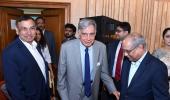In a relatively rare occurrence, the growth in manufacturing jobs exceeded the pace of sector growth in 2022-23 (FY23).

The number of persons engaged in the segment grew by 7.43 per cent in FY23, according to figures from the Annual Survey of Industries (ASI) released on September 30.
The gross value added for the manufacturing sector grew by 4.24 per cent in current prices and declined by 2.2 per cent in real terms for FY23, according to earlier annual figures released by the government.
The only previous instance in the past 20 years occurred during the pandemic disruption in 2019-20.
This trend may reflect a shift from the informal to the formal economy, suggested Santosh Mehrotra, a visiting professor at the University of Bath in the UK.
The informal sector was affected by three shocks: demonetisation, the introduction of the goods and services tax, and a harsh national lockdown during the pandemic.
Many informal businesses shut down, resulting in their market share shifting to formal entities captured in the ASI.
Consequently, formal companies have seen greater employment numbers to accommodate this shift.
However, overall manufacturing gross value added at the national level, which encompasses both informal and formal parts of the economy, has seen limited growth.
The demand is not there, said Mehrotra.
Unincorporated enterprises lost 5.4 million jobs between 2015-16 and FY23, Business Standard reported earlier.
Roughly 1.8 million establishments in the unincorporated sector closed during this period.
The increased formalisation has led many companies to invest more than before.
Fixed capital has grown at a faster pace than the number of persons engaged in factory work.
Fixed capital includes plant, machinery, buildings, and other long-term assets.
In FY23, fixed capital grew by 10.6 per cent compared to a 7.43 per cent increase in the number of persons engaged in such entities.
Rising capital intensity has been a long-term trend in Indian manufacturing, observed Amit Basole, professor of economics at Azim Premji University.
In itself, this is expected since technological advances generally imply a rising capital-labour ratio.
However, this can still be accompanied by job creation if the investment is large enough.
But if the rise in investment does not compensate for the increase in the capital-labour ratio, job creation will slow down, he said.
Machinery seems to be displacing some work, said Bino Paul, professor at the School of Management and Labour Studies at the Tata Institute of Social Sciences.
He noted that more skilled and thus more expensive blue-collar jobs, like welding, are often replaced by machines that can perform the same functions.
Overall employment figures may obscure the fact that the quality of available jobs has declined with increased investment in technology.
Meanwhile, the net value added per person has risen to a record high in FY23 after declining during the pandemic.
The net value added per person is a measure of labour productivity. However, growth in the latest year was slower than before.













 © 2025
© 2025